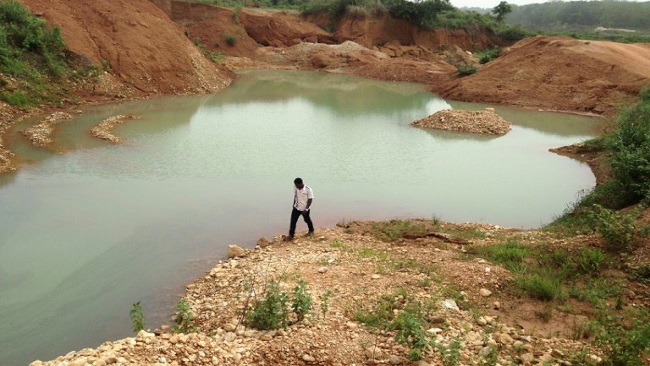After the gold rush: Mining boom in Cameroon leaves ‘open tombs’
For a time, the land around the village of Longa Mali in eastern Cameroon was one of the most prized in Africa, and powerful machines gnawed greedily into its soil to extract precious gold.
Today, abandoned with almost the same speed as it was coveted, the landscape is as dangerous as it is damaged, say campaigners.
Around a hundred deep holes lie around the village. Many of them are filled with water, making them a deadly risk for frolicking youngsters. In other locations, subsistence miners run the risk of being buried alive as they delve in deep, narrow holes for a few flecks of gold.
Longa Mali is one of dozens of places in Cameroon that are grappling with “open tombs” — the legacy left by mining companies.
Last year, at least 47 people died on former mining sites in Cameroon’s East Region, according to an NGO called Foder, a French acronym for Forests and Rural Development.
In late December, nine people aged between 18 and 32, including women, were killed in a landslide in the village of Ngoe Ngoe while they searched for gold.
Eugene Phausard, an official for the district of Betare Oya, graphically described the peril from “death lakes” — gaping holes that swiftly fill with water after the mining pumps are switched off and hauled away.
“Children regularly go to swim there,” ignoring the danger of playing in water that is up to 30 metres (100 feet) deep, he said.
“These holes have become open tombs,” added parish priest Patrice Baktala.
– ‘We live with the risk’ –
The problem results from a raw-edged cost-benefit analysis — when mining companies see that the extraction costs exceed the profits they move elsewhere.

Gold miners at a site in the Cameroon town of Betare Oya sift through earth and water to find minerals
Failure to fill in and rehabilitate abandoned sites is “one of the major issues we face,” said Gabriel Yadji, the regional head of the mines ministry.
At the beginning of April, four companies were banned from mining in eastern Cameroon, according to Foder.
During a peak in activity between 2011 and 2014, more than 100 mining companies were present in the region, most of them Chinese, but also Korean, Canadian, American and South African.
Officially, 285 kilos — a little more than 10,050 ounces — of gold were extracted in eastern Cameroon in 2017 by licensed companies.
The Kaye mine in Betare Oya, begun by a Chinese firm, has temporarily stopped operations while the company brings in bigger machines to exploit poorer seams.
But women with babies on their backs are busy sifting through the red soil while a young man down a narrow hole strikes the earth with a pickaxe.
“They don’t think about the risk of an accident,” says a security guard astride a motorbike. A policeman by training, the guard has been hired to disperse the amateur gold diggers.
“If there are accidents, they’ll blame the Chinese,” he said. “Even when someone is buried when their hole collapses, people come back the following day.”
“We live with the risk,” said local resident Daoudou Denis dismissively, as he scoured the earth.
– Environment also pays –
As well as the human cost, the gold rush has been “an ecological disaster” for the region, said Foder spokesman Justin Chekoua.
Degraded soil, deforestation and altered watercourses have swept away important parts of the ecological mix.

Young men dig with pickaxes in the hope of finding gold in the Cameroon town of Betare Oya
“People did a lot of fishing on mining territory, but there are no fish left. The waterways have silted up,” Chekoua said.
“There is no more arable land,” said Michel Pilo, head of Mali village. Tomatoes, plantain and cassava which used to be grown locally now come from far away — the areas where they used to be cultivated have been razed for mining.
“The companies have built no school, no health centre, no roads, they just exploited us,” said Philo.
The Betare Oya district should have collected more than 850 million CFA francs (1.3 million euros, $1.6 million) in mining royalties since 2014 but had received nothing to date, according to district official Phausard.
Source: The Citizen




